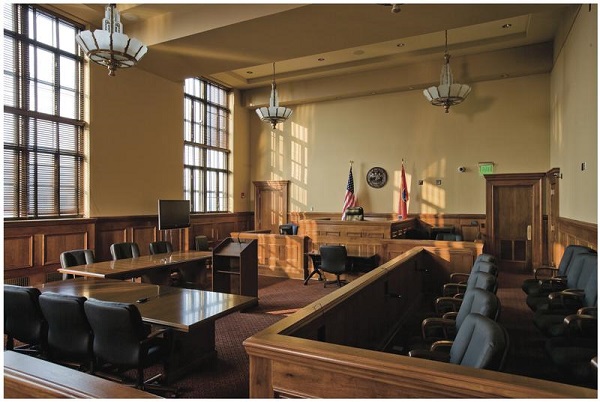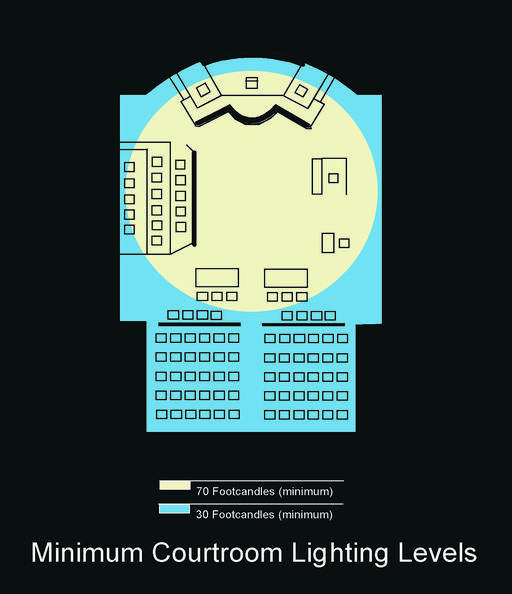Courtroom Lighting
Adequate lighting should be provided, with greater intensification in the litigation area. Changes in lighting are needed for displaying evidence, showing films, and using overhead projectors.
Court personnel should be able to make the necessary adjustments from their stations with a minimum of movement, using preset controls. A combination of fluorescent and incandescent lighting should be used, with spot illumination over key participants. Dimmer illumination can be used in the spectator area, but the judge should still be able to view all visitors clearly.
Designing a lighting system for a courtroom is a mixture of art and science. The system must not only provide an appropriate level of lighting for the various occupants but also complement the dignity of the courtroom. Energy conservation is equally important in selecting a lighting system. What used to be known as a "quantitative" design approach years ago has been replaced by the "qualitative" design approach, in which performance governs the selection of a lighting system.
A certain amount of contrast is both physically and psychologically required for everyone in the courtroom to see everything comfortably. Normal contrast (black letters on white paper) is easily perceived by the eyes, but low contrast (such as black letters on a dark gray surface) becomes more difficult, tending to strain the eyes. When planning the lighting system, three zones of contrast are important.
- The task itself, such as a piece of paper on a desk or an exhibit on view.
- Surfaces surrounding the task, such as the desk or wall. It is suggested that the second zone be slightly darker when the primary task is placed immediately adjacent to this zone.
- Distant surfaces, such as the floor, walls, and ceiling.
Whenever the contrast between two surfaces becomes too great, glare develops. Direct glare is caused by direct sunlight, bright windows, or an ex posed light source. Reflected glare occurs from light sources that are reflected off of highly specular finishes, such as polished marble. The latter type of glare is more common in courtrooms and can be controlled by reducing the specular quality of the task, as well as by relocating the light source out of the distracting zone.
When planning courtroom lighting, the following considerations should be made.
- Human Considerations: Lighting that is too bright or too low will create certain physiological and emotional reactions among participants that will affect the proceedings and the court's efficiency. Participants must be able to see one another and the evidence clearly without having to strain. Proper lighting also contributes to the security of the room.
- Interior Finishing: The type, color, and texture of finishes used for the floor, walls, ceiling, and fixed and movable furniture can adversely affect the lighting system's effectiveness in the courtroom. The interior finishes must be judged on their value of reflecting light as well as their aesthetics.
- Aesthetics: The lighting system must respect the dignity of the courtroom and not become an eye-catching design feature. Attention should not be drawn away from the testimony or the evidence being presented; the lighting system should enhance the subject.
- Performance Characteristics: The system must provide the level of lighting required for the specific task, the comfort that must be afforded, and the efficiency of the layout.
- Energy Consumption: Fixtures should be energy efficient-low wattage and low heat so as not to affect adversely the air conditioning and comfort level within the space. The operation of the lighting system should be cost-efficient.
- Maintenance: Fixtures must be easily serviceable and as maintenance-free as possible.
- Control Flexibility: Some functions performed in a courtroom require dimming controls. Their exact placement is critical, and consideration should be given to who operates the lighting controls and what happens if a disturbance begins when the lights are dimmed. A single control station for all lighting, audio, video, and security operations in the courtroom should be considered, as should the use of preset or preprogrammed lighting settings that can be activated by the push of a button. Manual slide dimmers should be discouraged when multiple banks of dimmers would become complicated to set manually during court proceedings.
- Security: Coordination of lighting levels with security camera sensitivity to light levels should be addressed early in the project.
A light source should make people look attractive. Furthermore, expensive interior finishes may be jeopardized if the lighting distorts the color. Incandescent lamps and warm white deluxe fluorescent lamps enhance a person's complexion, while cool white deluxe fluorescent lighting provides only fair performance, and deluxe white fluorescent lights offer poor performance. Consider the materials that may receive both sources of light; finishes should be selected under the primary lamp under which they will be installed.
The mounting of the luminaire affects the way light is distributed. The effect can be subtle or can make a dramatic architectural appearance.
Direct and Indirect Lighting
Both direct and indirect lighting is commonly used in courtrooms, while task/ambient lighting is usually found in offices.
With direct lighting, the light comes from the source to the workspace without being reflected. Control over the distribution of light is easier with direct lighting, even over a long time, and proper levels of light can be provided once the task is defined.
Indirect lighting, on the other hand, is light reflected from another surface, such as a wall or ceiling. Indirect lighting provides a more shadow-free environment, similar to an overcast day. Visual clarity is generally greater than with direct lighting, but objects such as desks or walls lose their definition due to the lack of contrast. Indirect lighting poses two concerns: First, the emphasis is placed away from the judge, diminishing the judge's importance. Second, over a period of time, the ceiling or wall, particularly if it is made of acoustical tile, will discolor and lose its ability to reflect. Painting these surfaces, particularly acoustical tiles, will ruin their sound-absorption properties.
A courtroom-lighting system must respond to several operational and physical issues, and a combination of direct and indirect lighting fixtures might be considered. An adequate level of lighting must be provided for the task performed, be sensitive to the occupants of the room, not be an economic burden to operate and service, and afford the dignity required in the space. By addressing these issues, a designer can provide a courtroom that will operate effectively and efficiently. Indirect lighting is being used more frequently in courtrooms because it reduces glare. For further information on courthouse lighting needs, please refer to the IES Lighting Handbook, published by the Illuminating Engineering Society of North America.
Lighting also influences the potential size and layout of office work areas (including the size of office modules and percentages of open-to-closed offices). Recent trends in office design have been toward the use of higher proportions of "shallow spaces," or spaces less than 35 feet in depth for office occupancies, reflecting increased use of individual and small-team office arrangements for staff and teams working in computer-intensive tasks.
Natural Lighting
 |
Natural Lighting in Courtroom at Metropolitan Courthouse - Nashville, Tennessee |
Natural lighting is greatly desired for workspaces because it keeps people connected to their environment. Space within 35 feet of a window is most suitable for open- or closed-office configurations. Depending on the design, the space within 20 feet of windows provides natural illumination and potential for external views. Open-plan offices can be arranged in a mixture of depths ranging between 20 and 35 feet from windows. Spaces beyond 35 feet from windows, known as "deep spaces," are typically less suitable for office occupancies, but are convenient for equipment and storage rooms because environmental control and access to services/elevators are easier.
Other means of providing natural lighting, even in courtrooms, include skylights, light wells, and interior windows to capture reflected light from exterior windows. While natural lighting is desirable for psychological and aesthetic reasons, courtrooms containing exterior windows can suffer from sunlight shadowing and dappling effects, heating, and cooling complications reduced security, exterior noise, and visual distractions. If exterior or natural, lighting is desired, skylights or other devices, rather than regular windows, can be used.
The design of office areas increasingly must consider the importance of natural light and external views to building occupants and the importance of light control to video display terminal (VDT) users. Displays should be positioned so that their sightlines are substantially parallel to windows to control view contrasts and to provide more visual comfort at the terminals. Users should not be positioned with their faces or backs to a bright window or luminaire, windows that are darker than surrounding walls, or windows with partly opened Venetian blinds (which may produce sharply defined light and dark stripes).
